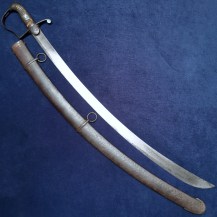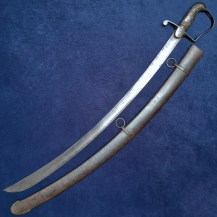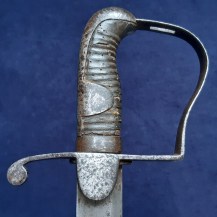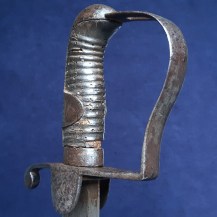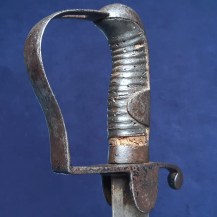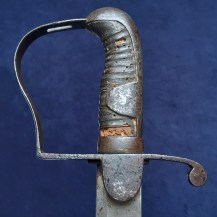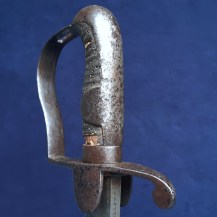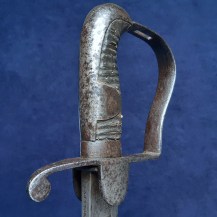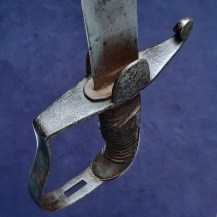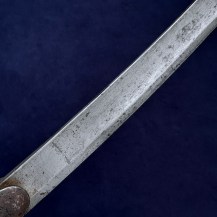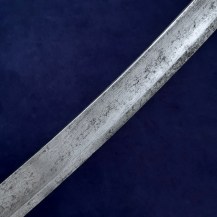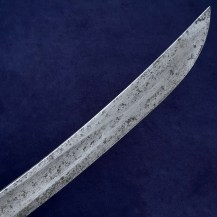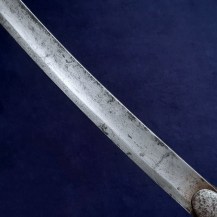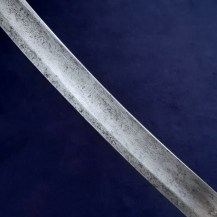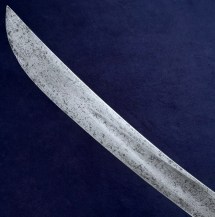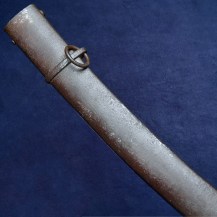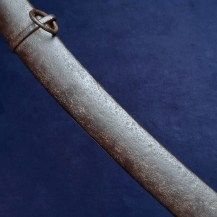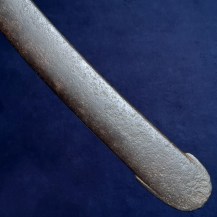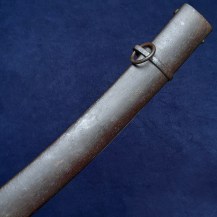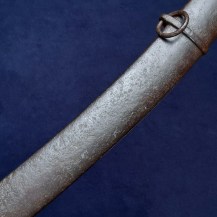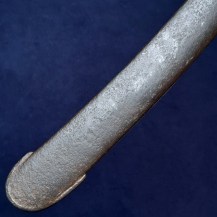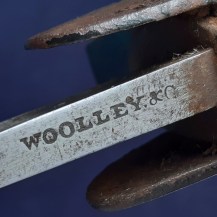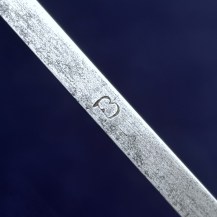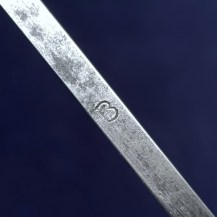British 1796 Pattern Light Cavalry Trooper’s Sword by Woolley & Co
Curved single-edged blade with fuller and hatchet point. Leather washer, iron stirrup P-shaped hilt with forward curving quillon, semicircular langets, iron backstrap and pommel cap. Ribbed wooden grip covered with pressed black leather. Plain steel scabbard with two bands and hanging rings. Blade 32 5/8 inches (82.9cm) in length past the washer, the sword 37½ inches (95.4cm) overall.
The spine of the blade is stamped with the maker’s mark ‘WOOLLEY & CO’, indicating the firm of James Woolley. There are also two balance points marked on the spine with lines and the letter ‘B’ – these indicate the points of balance of the bare blade and the fully hilted sword, and were part of the quality control process to check for errors in blade shape.
The cutler James Woolley first established a business in Birmingham in 1785. In 1790 the business moved to Edmund Street and James entered into the first of many partnerships, with the cutler Thomas Deakin. Deakin was very much a junior partner and some if not all blades continued to be marked with just Wooley’s name or ‘Woolley & Co.’ for the next ten years – ‘Woolley & Deakin’ was eventually used but probably not until around 1800 when Deakin begins to be named in business directories. We can say therefore that this sword is probably an earlier example of its type, pre-1800.
The blade has some speckled patination. Its edge has been sharpened and there are some small nicks to the upper half. Some scratching and small areas of light pitting toward the tip. The hilt, ferrule and backstrap were all originally painted black – this paint has worn in a number of areas leaving only small fragments, but is completely intact on the outer face of the hilt. This may indicate the sword was used by yeomanry. Where the paint has worn the exposed iron has dark speckled patination. The leather of the grip has some cracking and losses exposing the cord binding in places and the wood core on one side next to the ferrule. There are a number of old woodworm holes. There is fractional movement to the ferrule but the grip is solidly peened with no rattling. The scabbard has heavy patination and pitting overall, but is free of dents.
Designed by John Gaspard le Marchant, the 1796 Light Cavalry was the first British cavalry sword based not on tradition but on empirical analysis of what worked in combat. Le Marchant gained first-hand experience of cavalry fighting in the Flanders campaigns of 1793-95, and decided that other forces, particularly their Austrian allies, had superior equipment and training to the British:
“I have been busily engaged in making drawings of all the articles in the military equipages of our Allies which differ from our own… I have also paid particular observation to the mode of training the Austrian cavalry to the use of the sabre, in which their superiority over us is incredible.”
Swords in particular needed to change, existing types being in his view heavy and poorly balanced. For the heavy cavalry he recommended a near-copy of the Austrian Model 1775, while for the light cavalry, inspired by “the expertly used scimitar blades of the Turks, Mamelukes, Moors and Hungarians” Le Marchant argued for a lighter, shorter curved sword that could both cut and thrust. The design that emerged was in fact a pure cutting sword, very broad bladed, more strongly curved and with a simpler profile than its predecessor the 1788. In service the 1796 sowed fear, as an officer of the French Chasseurs recounted:
“Out of every twenty blows aimed by them, nineteen missed. If, however, the edge of the blade found its mark only once, it was a terrible blow, and it was not unusual to see an arm cut clean from the body.”
Le Marchant died in battle leading cavalry at Salamanca in 1812, but his swords carried on his legacy, with the regular Army until 1821 and with yeomanry units for decades longer – it was still in active use with yeomanry as of 1848, the 1821 Patterns seemingly not being introduced to many. The Prussian 1811 ‘Blucher’ sabre was a very close replica, and in India in particular the blade was a natural fit with an existing tradition of slashing sword technique. Spare blades were much in demand by native horsemen, typically mounted into their familiar tulwar hilts, and swords produced for Indian cavalry units as late as the 1910s used a blade modelled on that of the 1796.


